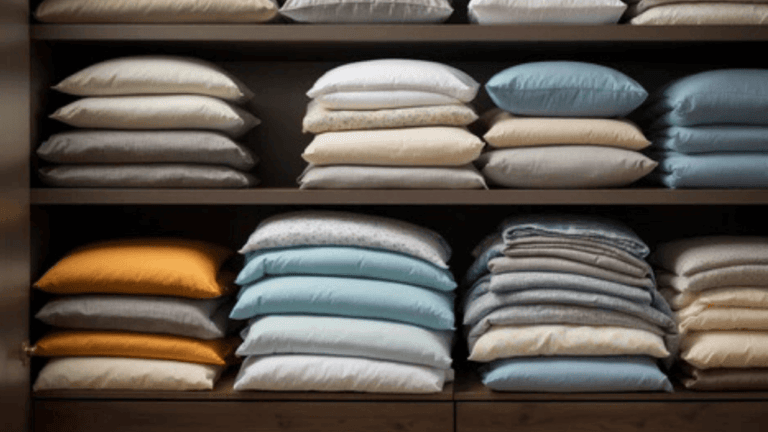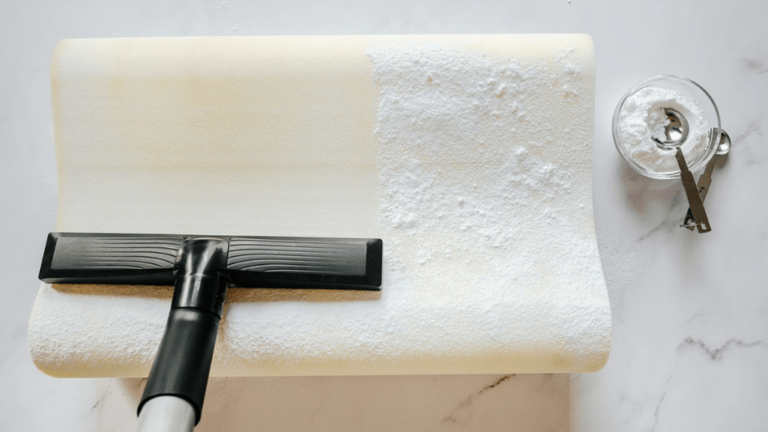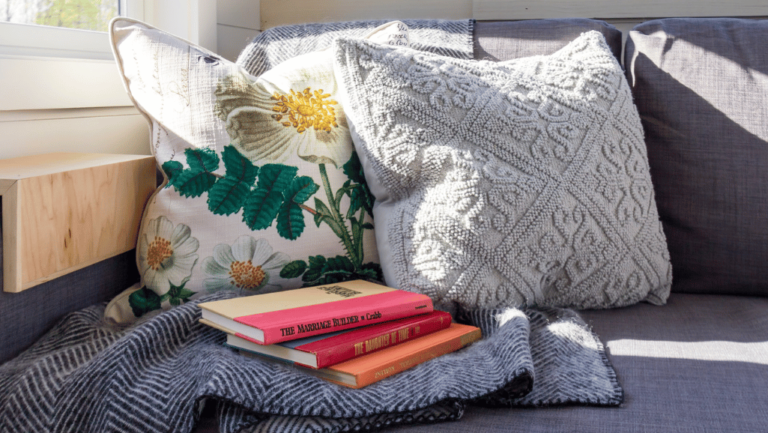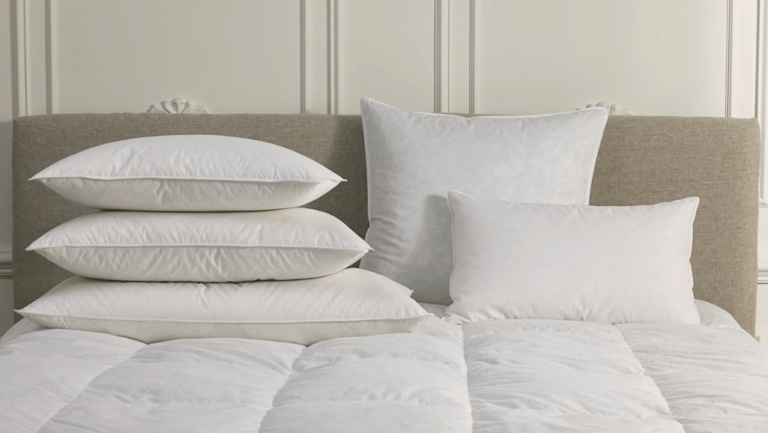Feather pillows add luxury to any bedroom, making sleep more comfortable. But, to keep them in top shape, you need to care for them right. Washing them at home is easier than you think. This guide will show you how to clean feather-filled pillows so they stay fresh and soft.
Looking after feather pillows is more than just washing them now and then. Using pillow protectors and cases helps keep them clean from oils and sweat. When it’s time to wash, follow the right feather pillow cleaning instructions to avoid damage. This ensures your pillows dry well and stay free from mold and mildew.
Key Takeaways
- Wash feather pillows every six months to a year, or as needed
- Use pillow protectors to extend time between washings
- Wash two pillows at a time for balanced loading
- Choose a gentle, low-sudsing detergent and delicate cycle
- Dry thoroughly on low-heat or no-heat setting, fluffing between cycles
- Fluff and reshape pillows after drying to break up clumps
- Replace feather pillows every 7-10 years for optimal support
Understanding Feather Pillows
Feather pillows are known for their softness and ability to mold to your head and neck. They provide great support and comfort. Goose feather pillows are especially popular for their high-quality filling.
What is a Feather Pillow?
Feather pillows use the wing and back feathers of geese or ducks. These feathers are flat and have quills, making the pillow firmer than down pillows. They are good for many sleepers but need fluffing often to keep their shape.
Difference Between Down and Feather Pillows
Down and feather pillows come from the same birds but are different. Down pillows use the soft undercoat of geese or ducks. This undercoat traps air, making the pillow soft and light.
| Characteristic | Down Pillows | Feather Pillows |
|---|---|---|
| Filling | Soft, fluffy undercoating | Flatter, quilled feathers |
| Feel | Plush, lightweight | Firmer, more supportive |
| Shape Retention | Excellent | Requires more frequent fluffing |
| Lifespan | Longer, up to 10+ years | 5-10 years with proper care |
| Cost | More expensive | Generally more affordable |
Knowing the differences between down and feather pillows helps you pick the best one for you. Both have their benefits, but taking good care of your feather pillows is key to making them last longer.
Preparing to Wash Your Feather Pillows
Before you start washing your feather pillows, make sure you have everything you need. Also, check your pillows for any damage. These steps will make washing easier and keep your pillows in good shape.
Gather Necessary Supplies
To wash your feather pillows right, you’ll need a few things. These include:
- A gentle, low-sudsing detergent for delicate items
- A washing machine with a delicate cycle
- A clean, dry spot for drying your pillows
It’s key to use a low-sudsing detergent. Regular detergents can leave residue that makes feathers clump. This can ruin the pillow’s loft and comfort.
Inspect Pillows for Damage
Before washing, check your pillows for damage. Look for rips, tears, or loose seams. Even small holes can let feathers out, making the pillow flat.
If you find damage, fix it first. Use a needle and thread to mend rips or tears. Make sure the stitching is strong to last through washing. Fixing damage before washing helps your pillows last longer and stay comfy.
| Inspection Checklist | Importance |
|---|---|
| Check for rips, tears, or loose seams | Prevents feather loss during washing |
| Repair any damage with a needle and thread | Ensures pillow integrity and longevity |
| Remove pillowcases or protective covers | Allows for thorough cleaning of the pillow itself |
By getting the right supplies and checking your pillows, you’re ready to clean them. This will keep your feather pillows in great shape.
Washing Feather Pillows in the Washing Machine
Washing feather pillows at home is easy. Most pillows fit in a standard washing machine. You can use any washer as long as the pillows fit.
When putting pillows in the washer, place them vertically. This helps avoid damage from the agitator. The Down & Feather Company suggests using a gentle detergent to prevent clumping.
| Washer Setting | Recommendation |
|---|---|
| Water Temperature | Warm or cool water to avoid damaging feathers while killing dust mites |
| Cycle Type | Delicate or gentle cycle to minimize wear and tear on the pillows |
| Spin Speed | Low or medium spin speed to reduce stress on the feathers |
| Extra Rinse | Add an extra rinse cycle to remove excess moisture and soap residue |
Washing two pillows at the same time helps balance the washer tub for better performance.
By following these guidelines and choosing the right washer settings, you can clean your pillows well. This helps keep them in good condition for longer.
Remember, washing feather pillows too often can make them brittle and prone to breaking. To keep your pillows in good shape, wash them once a year. This gets rid of dust mites and bacteria.
Balancing the Washer Load
When washing feather pillows, it’s key to keep the washer balanced. This ensures the pillows get cleaned well without harming the machine. A balanced load means the pillows are washed evenly, keeping both the pillows and the washer safe.
Importance of Washing Two Pillows at a Time
Washing two pillows together is the best way to clean them. This method keeps the washer balanced, avoiding damage from uneven loads. An unbalanced load can shake the washer too much, causing it to break or the pillows to clump.
Washing two pillows at a time helps balance the load in the washing machine.
Loading Pillows Vertically
It’s important to put pillows upright in the washer. This setup lets water and detergent move around better, ensuring a deep clean. It also stops the pillows from getting tangled or squished, which can harm the feathers.
| Pillow Placement | Benefits |
|---|---|
| Washing two pillows at a time | Balances the load in the washer, preventing uneven cleaning and damage to the machine |
| Loading pillows vertically | Allows for better circulation of water and detergent, ensuring thorough cleaning and minimizing the risk of tangling or compression |
By following these tips, you can wash your feather pillows well. This way, they get cleaned right without harming the pillows or the washer.
Choosing the Right Detergent and Wash Settings
Washing your feather pillows right is key to keeping them in good shape. The right detergent and wash settings are important. Here’s what you need to know:
Using a Gentle, Low-Sudsing Detergent
Choose a low-sudsing detergent for feather pillows. This type of detergent helps prevent feathers from sticking together. Use a high-efficiency, low-suds powder detergent. Use less detergent than you would for regular clothes to avoid a lumpy pillow.
Selecting the Delicate Cycle
Always pick the delicate cycle when washing feather pillows. This gentle setting helps avoid damaging the pillow. Some feather pillows can be machine-washed, but do it carefully to keep them fluffy. If your pillow says “dry clean only,” have it professionally cleaned to keep it looking good.
Deciding on Water Temperature
Water temperature is also important. Hot water kills dust mites but can harm the feathers. Use cold or warm water to clean your pillows. The gentlest cycle on your washer will also help protect your pillows.
| Detergent Type | Amount to Use | Effect on Feather Pillows |
|---|---|---|
| High-efficiency, low-suds powder detergent | Reduced amount (less than normal laundry) | Minimizes clumping and maintains loftiness |
| Regular detergent | Normal amount | May lead to excess suds, difficulty in rinsing, and flattened or lumpy pillows |
By picking the right detergent, wash cycle, and water temperature, you can clean your feather pillows well. Always check your pillow’s care label for the best cleaning results.
Extra Rinse and Spin Cycle
When washing feather pillows, it’s key to add an extra rinse cycle for pillows. This step removes all soap and dirt. Any leftover soap can make the feathers clump, making the pillow uncomfortable.
Experts say to add an extra rinse and spin cycle. This helps remove extra moisture and soap. It’s important for down pillows.
After rinsing extra, use a spin cycle for feather pillows to get rid of water. The spin cycle is vital for removing excess moisture from feathers. This cuts down drying time and stops mold and mildew growth. Use a high-speed spin cycle to get the most water out.
| Washing Machine Type | Extra Rinse Cycle | Spin Cycle Speed |
|---|---|---|
| Front-loading | 1 extra rinse | High-speed (1200+ rpm) |
| Top-loading | 1-2 extra rinses | High-speed (800+ rpm) |
To clean and dry feather pillows well, follow these tips:
- Always use an extra rinse cycle to remove soap residue and dirt
- Utilize a high-speed spin cycle to extract maximum moisture
- Repeat the rinse and spin cycle if necessary for heavily soiled pillows
The extra rinse and spin cycle may add some time to your washing routine, but it’s a crucial step in maintaining the quality and longevity of your feather pillows.
By adding an extra rinse and spin cycle to your feather pillow washing, you ensure they’re clean and dry. This simple step keeps your pillows comfortable and durable for years.
Drying Feather Pillows
After washing your feather pillows, it’s key to dry them right. This keeps them fluffy and stops damage. With the right steps, your pillows will stay great for a long time.
Removing Excess Water Before Drying
First, squeeze out extra water from your pillows. Use two clean towels to press them. This helps remove water without harming the feathers. Peacock Alley’s guide says this step is vital to avoid mold and mildew.
Using a Low-Heat or No-Heat Setting
When drying, use a low-heat or no-heat setting. High heat can hurt the feathers, making them brittle. Feathers have oils that protect them, and washing can remove these oils. A low-heat setting helps keep these oils and makes your pillows last longer.
| Dryer Setting | Benefits |
|---|---|
| Low-heat | Gentle on feathers, preserves natural oils |
| No-heat | Safest option for delicate feathers |
Fluffing Pillows Between Dryer Cycles
Fluff your pillows often to dry evenly and avoid clumps. Take them out of the dryer every 15-20 minutes. Fluff them by hand to break up any clumps. Using dryer balls can also help keep them fluffy.
The lifespan of a feather pillow is around 7 – 10 years if not washed unnecessarily, with proper fluffing and care to maintain support and prevent clumping.
Remember, keeping your feather pillows dry is crucial to prevent mold and mildew growth. Dry them well before using or storing them. With the right care, your pillows will stay fluffy and supportive for years.
Fluffing and Reshaping Feather Pillows
After washing and drying your feather pillows, it’s important to fluff and reshape them. Fluffing feather pillows is a key step in keeping them comfortable and supportive.
Breaking Up Feather Clumps
Washing and drying can cause feathers to clump. To fix this, gently massage the pillow. This spreads the feathers out evenly, making the pillow comfortable and supportive again.
Holding Pillows by Corners and Shaking
After breaking up clumps, hold the pillow by the corners and shake it. This action spreads the feathers out and fluffs them up. It makes the pillow soft and lofty again.
To keep your feather pillows in good shape, follow these tips:
- Fluff your pillows every day to stop feathers from clumping
- Use pillow protectors to wash them less often
- Don’t let your pillows get direct sunlight or heat, as it can damage the feathers and make them smell bad
Fluffing and reshaping your feather pillows after washing keeps them cozy and supportive. This ensures a good night’s sleep.
Freshening Feather Pillows Between Washes
Keeping your pillows clean is key for a good night’s sleep. Washing feather pillows is important, but you can also freshen them up between washes. This helps them last longer and smell better. Here are some easy ways to keep your feather pillows fresh:
- Put your feather pillows in the dryer with a damp washcloth, a few dryer balls, and a fabric softener sheet.
- Use a low-heat or air-fluff setting and tumble dry for 15-20 minutes.
- The damp washcloth, dryer balls, and fabric softener will fluff the feathers, remove odors, and make them smell fresh.
Fluffing your feather pillows by hand is also helpful. It keeps the feathers even and prevents clumping. To fluff, hold the pillow by the corners and shake it gently. Then, press the sides together to reshape it.
Fluffing feather pillows by hand can help reorganize the feathers within the pillow for better support.
Using pillow protectors and pillowcases is also good. They help manage oils and moisture, making your pillows last longer. People who wash their hair at night should make sure it’s dry before bed. This prevents moisture from getting into the pillow.
| Freshening Technique | Frequency | Benefits |
|---|---|---|
| Tumble drying with damp washcloth, dryer balls, and fabric softener sheet | Every 1-2 months | Fluffs feathers, removes odors, and leaves pillows smelling fresh |
| Fluffing pillows by hand | Weekly | Redistributes feathers evenly, prevents clumping, and ensures proper support |
| Using pillow protectors and pillowcases | Continuously | Manages compression, body oils, and moisture, extending pillow lifespan |
By using these simple techniques, you can keep your pillows clean and comfy. This also makes them last longer. Remember, taking care of your pillows is an investment in your sleep and health.
How to Wash Feather Pillows
Feather pillows add luxury to your bed, making sleep better. They last 5-10 years with the right care. Here’s how to wash them well and keep them fresh.
Step-by-Step Guide to Washing Feather Pillows
- Take off any covers and check for damage. Fix any leaks or tears before washing.
- Put two pillows in your washer at once. This balances the load and cleans better.
- Use a mild detergent without additives. Gentle cleaners avoid feather clumps.
- Choose the delicate cycle and extra rinse. This removes all soap.
- After washing, squeeze out water gently. Don’t wring or twist to avoid feather damage.
- Put pillows in the dryer on low heat. Add wool dryer balls or tennis balls to fluff them.
- Check and fluff pillows every 15-20 minutes. This keeps them fluffy and prevents matting.
- Keep drying until pillows are dry. Damp feathers can cause mold and mildew.
Tips for Ensuring Pillows are Thoroughly Cleaned and Dried
- Always wash two pillows at once for better washing.
- Use a front-loading washer for delicate items like feather pillows.
- Choose a mild detergent for delicate items to avoid clumps.
- Do an extra rinse cycle to remove all detergent.
- Squeeze out water gently but avoid wringing or twisting.
- Use low heat in the dryer and fluff pillows often to prevent matting.
- Make sure pillows are dry before using them again to avoid mold and mildew.
Follow this step-by-step pillow washing guide and these tips for cleaning. Wash your feather pillows every 6 months to a year to keep them fresh and supportive.
Maintaining the Longevity of Your Feather Pillows
To keep your feather pillows comfy and supportive, follow some simple steps. Regular fluffing, using pillow protectors, and washing them at the right time are key. These habits help your pillows last longer and stay soft.
Using Pillow Protectors
Pillow protectors are a great way to protect your feather pillows. They keep out oils, sweat, and wear. High-quality protectors mean less washing, which is good for your pillows.
For the best pillow protectors, check out Peacock Alley.
Regularly Fluffing Pillows
Fluffing your pillows daily is important. It keeps the feathers evenly spread and the pillow firm. This simple act can make a big difference in comfort and support.
“Fluffing your feather pillows daily is a small but impactful way to maintain their shape and comfort. It’s a simple habit that can make a big difference in the long run.”
Washing Pillows Every 6 Months to a Year
Even with regular care, washing your pillows every 6 months to a year is needed. It removes dust mites, bacteria, and dirt. Here’s how to wash them right:
- Wash two pillows at a time to balance the washer load
- Use a gentle, low-sudsing detergent specifically designed for delicate fabrics
- Select the delicate cycle on your washing machine
- Opt for an extra rinse and spin cycle to remove excess moisture and soap residue
- Dry your pillows on a low-heat or no-heat setting, fluffing them between dryer cycles
| Pillow Washing Frequency | Benefits |
|---|---|
| Every 6 months | Optimal cleanliness and hygiene |
| Every 12 months | Balances cleanliness with pillow longevity |
By following these tips, your feather pillows will last longer. This means more comfort and support for you. It’s a smart way to get the most from your pillows.
Conclusion
Proper care of feather pillows is key to keeping them comfortable and long-lasting. Knowing how to wash them right helps a lot. It’s important to wash feather pillows every six months to a year, depending on how often you use them.
Using pillow protectors can also help. They keep your pillows clean by blocking stains and dust mites. Fluffing and airing out your pillows regularly also helps keep them in good shape.
Feather pillows can last 7-10 years if you take good care of them. By following this guide and keeping up with care, you’ll enjoy your pillows for many nights. This makes them a great investment for your sleep.















